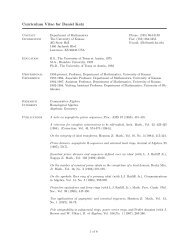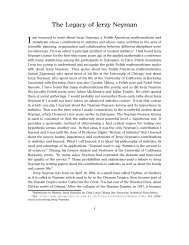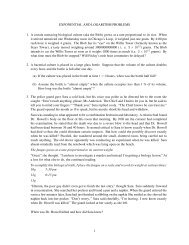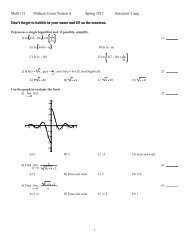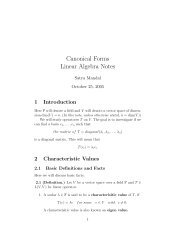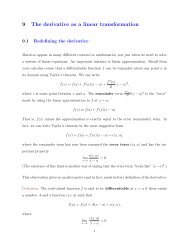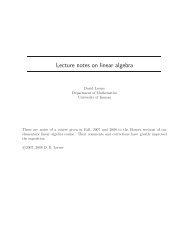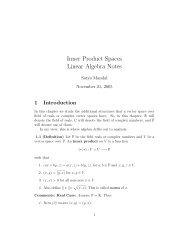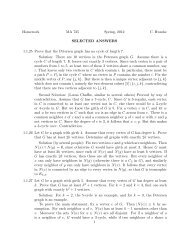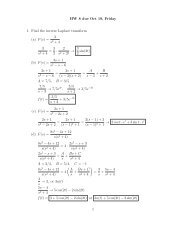f a f a X Y f( )a ( ) ( ) af fay y= = Figure 2.2: Errors in a pratical situation f
f a f a X Y f( )a ( ) ( ) af fay y= = Figure 2.2: Errors in a pratical situation f
f a f a X Y f( )a ( ) ( ) af fay y= = Figure 2.2: Errors in a pratical situation f
Create successful ePaper yourself
Turn your PDF publications into a flip-book with our unique Google optimized e-Paper software.
Lecture 3 (Tue, Aug. 28). Condition<strong>in</strong>g<br />
Consider a general problem (f(x)) which is well def<strong>in</strong>ed. Suppose we have the <strong>in</strong>put x = a<br />
and we need to f<strong>in</strong>d the result (answer) y = f(a). Now suppose we use a method ˆ f(x) to<br />
approximate f(x) with an <strong>in</strong>put â that is close to a with an absolute backward error |a − â|.<br />
Here |·|| is a certa<strong>in</strong> measure (norm). Then with a certa<strong>in</strong> measure (norm) |·|| that might be<br />
different from the one for a, the absolute error of the result is |f(a) − ˆ f(â)|, which is called<br />
the absolute forward error.<br />
The error <strong>in</strong> the result (by ignor<strong>in</strong>g the norm) can be decomposed <strong>in</strong>to two parts (Fig-<br />
ure <strong>2.2</strong>):<br />
f(a) − ˆ f(â) = f(a) − f(â)<br />
<br />
+ f(â) −<br />
Propagated data error<br />
ˆ f(â)<br />
<br />
Computational error<br />
The computational error is caused by the approximation of the method. The propagated<br />
<strong>Figure</strong> <strong>2.2</strong>: <strong>Errors</strong> <strong>in</strong> a <strong>pratical</strong> <strong>situation</strong><br />
a<br />
a<br />
X<br />
f<br />
f<br />
f<br />
Y<br />
y = fa ( )<br />
f( a)<br />
<strong>y=</strong> f(<br />
a)<br />
data error is caused the sensitivity of the problem itself.<br />
The condition<strong>in</strong>g of a problem f is about to sensitivity of the result f(a) to a small<br />
change <strong>in</strong> a. The absolute condition number κf(a) is def<strong>in</strong>ed by<br />
κf(a) = lim sup â→a<br />
If f is a function and is differentiable at a, then<br />
κf(a) = |J(a)|,<br />
|f(a) − f(â)|<br />
.<br />
|a − â|<br />
1
2<br />
where J(x) is the Jacobian of f(x). Obviously, for any â close to a,<br />
|f(a) − f(â)| ≈ κf(a)|a − â|.<br />
So κf(a) is large, a small change <strong>in</strong> a may result <strong>in</strong> a large change <strong>in</strong> f(a). In this case, we<br />
say the problem is ill-conditioned. Otherwise it is well-conditioned.<br />
Similarly, when a = 0 and f(a) = 0, us<strong>in</strong>g the relative backward error |a − â|/|a| and<br />
relative forward error |f(a) − f(â)|/|f(a)|, we can def<strong>in</strong>e the relative condition number<br />
˜κf(a) = lim sup â→a<br />
If f(x) is differentiable at a, then<br />
When â is close to a,<br />
|f(a) − f(â)|/|f(a)|<br />
|a − â|/|a|<br />
˜κf(a) = |a|<br />
|f(a)| |J(a)|.<br />
|f(a) − f(â)|<br />
|f(a)|<br />
≈ ˜κf(a)<br />
|a − â|<br />
.<br />
|a|<br />
= |a|<br />
|f(a)| κf(a).<br />
Aga<strong>in</strong>, ˜κf(a) measures the sensitivity of f(x) at a, but <strong>in</strong> a relative sense.<br />
Example 3.1 Let f(x) = √ x. Determ<strong>in</strong>e κf and ˜κf at a > 0.<br />
Solution. S<strong>in</strong>ce J(a) = f ′ (x) = 1/(2 √ a),<br />
κf(a) = |J(a)| = 1<br />
2 √ a , ˜κf(a) = a<br />
√ |J(a)| =<br />
a a<br />
√<br />
a<br />
1<br />
2 √ a<br />
= 1<br />
2 .<br />
Hence, <strong>in</strong> absolute sense, the problem is ill-conditioned when a is close to 0, and it is well<br />
conditioned when a is away from 0, say a ≥ 1.<br />
In relative sense, the problem is well-conditioned for any a > 0 (even for a = 0 <strong>in</strong> the<br />
limit sense).<br />
Example 3.2 In this example we <strong>in</strong>vestigate how a root of a polynomial will change when<br />
an error is <strong>in</strong>troduced to a particular coefficient. Let p(x) = a0 + a1x + . . . + anx n and λ be<br />
a s<strong>in</strong>gle root of p(x) = 0. (That means p(x) = (x − λ)q(x) and q(λ) = 0.) It is well-known<br />
that λ is a function of the coefficients a0, . . . , an. In particular, λ is a function of ai for some<br />
i when other coefficients rema<strong>in</strong> unchanged. Let λ = f(ai). Determ<strong>in</strong>e κf(ai) and ˜κf(ai).<br />
Solution. The function λ = f(ai) is a s<strong>in</strong>gle variable function. S<strong>in</strong>ce λ is a s<strong>in</strong>gle root of<br />
p(x), f(ai) is differentiable. We need to f<strong>in</strong>d f ′ (ai).<br />
Because λ is a root of p(x) = 0,<br />
p(λ) = a0 + a1λ + . . . + ai−1λ i−1 + aiλ i + ai+1λ i+1 + . . . + anλ n = 0.<br />
Differentiat<strong>in</strong>g both sides with respect to ai we have<br />
[a1 + . . . (i − 1)ai−1λ i−2 + iaiλ i−1 + (i + 1)ai+1λ i + . . . + nanλ n−1 ]f ′ (ai) + λ i = 0,
or equivalently<br />
So<br />
and<br />
p ′ (λ)f ′ (ai) = −λ i ⇒ f ′ (ai) = − λi<br />
p ′ (λ) .<br />
κf = |f ′ (ai)| = |λ|i<br />
|p ′ (λ)| ,<br />
˜κf = κ |ai|<br />
|λ|<br />
i−1 |ai||λ|<br />
=<br />
|p ′ .<br />
(λ)|<br />
Roughly speak<strong>in</strong>g, the problem of f<strong>in</strong>d<strong>in</strong>g a root of a polynomial equation is ill-conditioned<br />
if p ′ (λ) is small. In particular, when λ is a multiple root, p ′ (λ) = 0 and κf = ∞ (˜κf = ∞).<br />
3





